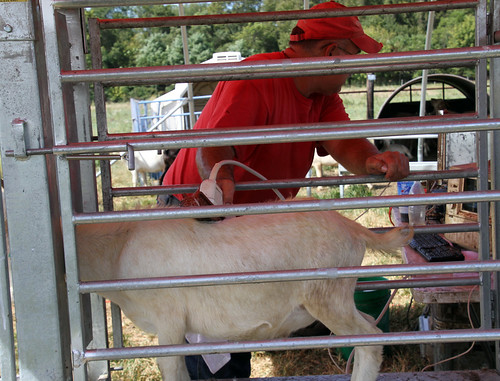The bucks were scanned today. The ultrasound scanning was done by Jim Pritchard from West Virginia. Jim has probably scanned more goats than anyone else. He has been scanning the bucks in the test for many years. Prior to scanning, the bucks were clipped between the 12th and 13th rib.
The scan data will be sent to the Centralized Ultrasound Processing (CUP) Lab in Iowa for processing. The CUP Lab™ will provide rib eye area, rib eye depth, and back fat measurements. The goats have so little back fat that this data is generally irrelevant. Unlike other livestock, goats deposit most of their fat internally. Unfortunately, there's no way to predict kidney and heart fat. With that said, the test goats are very lean; they would not be expected to have much internal fat.
Rib eye area is strongly correlated to weight and age; older, heavier goats usually have larger rib eyes. In the test, comparisons will be based on weight. Goats weighing 40 to 50 lbs. will be compared to other goats weighing 40 to 50 lbs. and so forth.
In other livestock species, there is a good correlation between ultrasound measurements and carcass measurements. There is also a good correlation between rib eye area and total carcass muscling.
For the past six years, the Maryland test site has collected ultrasound and carcass data on goats. This data is being analyzed to determine the correlation between ultrasound measurements and carcass measurements and correlations between rib eye area and carcass muscling.
 |
| Jim Pritchard scanning one of the bucks |
The scan data will be sent to the Centralized Ultrasound Processing (CUP) Lab in Iowa for processing. The CUP Lab™ will provide rib eye area, rib eye depth, and back fat measurements. The goats have so little back fat that this data is generally irrelevant. Unlike other livestock, goats deposit most of their fat internally. Unfortunately, there's no way to predict kidney and heart fat. With that said, the test goats are very lean; they would not be expected to have much internal fat.
Rib eye area is strongly correlated to weight and age; older, heavier goats usually have larger rib eyes. In the test, comparisons will be based on weight. Goats weighing 40 to 50 lbs. will be compared to other goats weighing 40 to 50 lbs. and so forth.
 |
| Which buck will have the largest rib eye? |
In other livestock species, there is a good correlation between ultrasound measurements and carcass measurements. There is also a good correlation between rib eye area and total carcass muscling.
For the past six years, the Maryland test site has collected ultrasound and carcass data on goats. This data is being analyzed to determine the correlation between ultrasound measurements and carcass measurements and correlations between rib eye area and carcass muscling.











